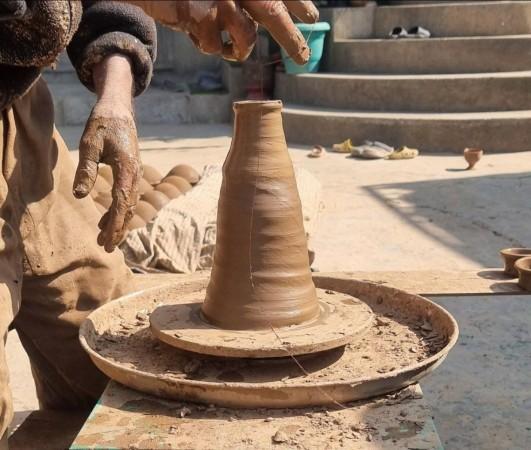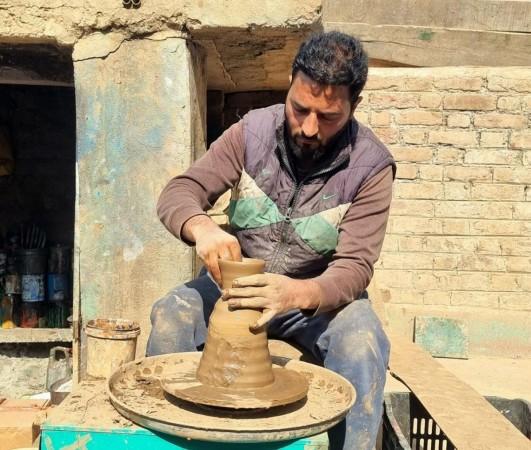
As Kashmir navigates the turbulent weeks following the April 22 terrorist attack in Pahalgam, which shook the region's fragile peace and threatened its tourism-driven economy and normal life. Kashmir is slowly working to recover not just from the immediate human loss but from the broader economic and psychological toll.
Amid this period of instability, some Kashmiris are finding quiet ways to rebuild and reclaim a sense of continuity. In Ishber Nishat, on the outskirts of Srinagar, a quiet revolution is taking shape, one molded by clay, fire, and an unyielding passion to preserve Kashmir's fading heritage. Mohammad Umar Kumar, a 29-year-old commerce graduate, is at the forefront of a revival, bringing back to life the almost-forgotten tradition of glazed pottery, locally known as Dalgate pottery.
Once a vibrant cornerstone of Kashmiri culture, this distinctive craft was slipping into obscurity, its earthen beauty overshadowed by mass-produced alternatives. But Umar, driven by a deep connection to his roots, refused to let it vanish.
"I completed my B.Com from Kashmir University in 2019, but I actually joined the pottery business way back in 2014," Umar told International Business Times. "I saw that this art and culture were vanishing, and I chose to revive it."

Glazed pottery in Kashmir wasn't just utilitarian; it was ceremonial, cultural, and communal. From brewing beverages to preparing traditional meals, clay pots were once woven into the rhythm of everyday life. But as modernity replaced tradition, potters vanished. Umar was determined to relight the flames.
With no formal training but immense dedication, he immersed himself in the process. He began by learning basic pottery skills from his father. Then, in 2019, he mastered the art of glazed pottery, a craft that hadn't been widely practiced in Kashmir since the early 2000's under the guidance of Ghulam Mohammad, an elderly artisan from Khanyar believed to be the last custodian of the technique.
From sourcing clay from the mountains, specifically the second layer of soil, to the intricate filtering, kneading, and mixing done entirely by hand.
"The more care you take with the clay, the more it rewards you," he says.
Among his creations are traditional items like the Tumbakh Nari, used in wedding ceremonies, and the Bugwari, a decorative container once used to store heirlooms. These artifacts don't just hold memories; they carry the essence of Kashmir's identity.
Umar's efforts haven't gone unnoticed. In 2023, he received the Union Territory Award for pottery, a recognition of his relentless work in preserving this endangered art. Government assistance came in the form of a potter's wheel, but most of the work is still done by hand.

Media coverage since 2019 has brought growing visibility to his work. "Through media highlights, we gained some fame; now people have started recognizing and embracing this art again," he says with quiet pride.
Today, Umar runs a wholesale pottery business, distributing handmade clay items throughout the Kashmir Valley. His small unit functions on a unique decentralized model; he collaborates with 15 to 16 artisans who work from their homes.
"We assign them work and later collect the items," he explains. "There isn't enough space here for everyone to work together, but this way we keep the production going."

More than just a craftsman, Umar is a messenger of cultural preservation and self-reliance. "The pottery items are chemical-free they're pure and good for health," he says. "Kashmir is known for its art, and we're happy that the demand for this craft is growing nowadays."
To unemployed youth, he offers a simple but powerful message: "Start something of your own. The government has many schemes to support livelihoods. And above all embrace your culture."
Umar dreams of expanding his efforts. "I'm planning to start a factory," he says. "And I'll try to provide employment to as many people as possible."
Through clay and commitment, Mohammad Umar Kumar is not just reviving an art form he's bringing back pride in Kashmir's rich artistic legacy and urging a new generation to mold their future with their own hands.













